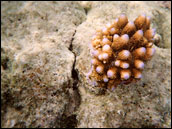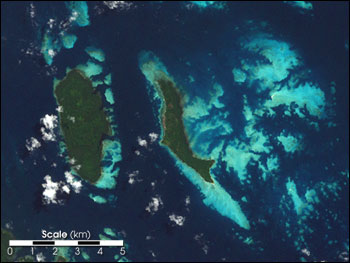

A Future of Freak Events | |||
It seems almost too coincidental to be real—a freak occurrence of negative synergy in which an unlikely sequence of seemingly unrelated events collided in a dangerous intersection to produce something not better than the sum of the parts, but far, far worse. The Indian Ocean Dipole brought lots of cool, nutrient-rich water up from the ocean floor, while El Niño caused a drought over Sumatra. Because humans had degraded the forest through logging, clearing, and accidental burning, forest fires raged out of control across Indonesia. With the Dipole came strong easterly winds that blew the smoke out over the ocean. The Dipole’s cool ocean temperatures chilled the air, and so the smoke didn’t rise away from the reefs. The iron-rich fallout from the smoke added the final nutrient to the already rich broth of deep-sea water, spawning a massive red tide that destroyed nearly 100 percent of a 400-kilometer long reef system. It would be nice to hope that such a devastating event was a fluke so coincidental that it would likely never happen again. Unfortunately, that hope may be misplaced. “The combination of natural and human influences in 1997 created a situation that appears to have been unprecedented over at least the past 7,000 years,” says Abram. “However, wildfires are becoming stronger and more frequent with increasing human pressures on tropical forests, and pollution and over-fishing are reducing the ability of reef ecosystems to naturally limit the extent of algae blooms, so it is likely that the threat [to reefs] from wildfires will increase in the future. The increasing threat from wildfires and subsequent large algae blooms applies not only to coral reefs, but also to any coastal marine ecosystem.” |

Years after the 1997 catastrophe, the Mentawai Island reefs are slowly recovering. This juveneil coral, photographed in mid-2001, is growing on the skeleton of a coral killed in 1997. (Photograph courtesy Kriton Glenn) | ||

Abram says that we can shield reefs from such catastrophe by reducing over fishing, water pollution, and other pressures that weaken the natural defense mechanisms that reefs use to fight off algae. But Abram’s study reveals that we must turn our gaze toward the land as well, becoming better caretakers and managers of tropical forest ecosystems. The closer we look at the way the world works, the more we realize how complex and interconnected it is. If we are going to prevent catastrophes like the Mentawai Reef death, strategies for exploiting and protecting natural resources are going to have to match the natural world’s intricacy and sophistication.
|
The world’s underwater ecosystems, including these reefs north of the Mentawai islands, but still in the zone of reef death, continue to be at risk from human activities. Direct threats like pollution and over-fishing can weaken reefs and make them unable to cope with shifts in climate or sudden environmental shocks, such as the massive red tide of 1997. This true-color image was acquired on July 9, 2001. (Landsat 7 image courtesy Remote Sensing of Coral Reefs) | ||